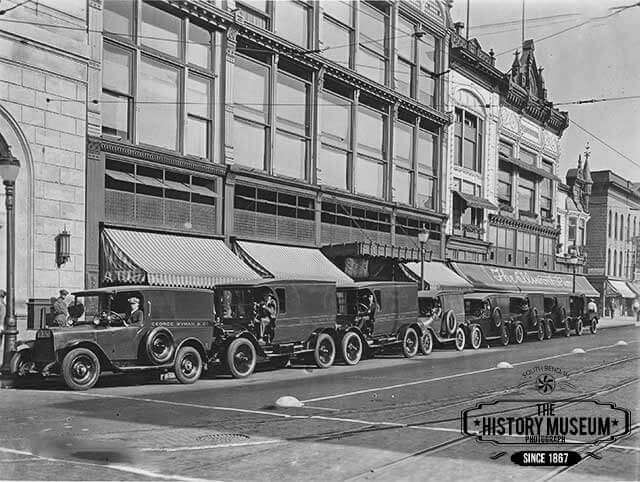Ellsworth’s Department Store
Location: 111-117 N. Michigan St., South Bend
Ellsworth’s Department Store was founded in 1832 by a New Englander, John Chess. Ellsworth’s began its existence as a trading post in the tiny settlement known as South Bend, the name taken from its location on the south bend of the St. Joseph River.
Trading consisted in the barest essentials of life and was carried on with the local settlers, those up the river in the then larger settlement of Mishawaka, and with the Indians. Barter, as well as cash, was the rule of the day. Dry goods, notions and trinkets from New England were the principal stocks and were transported here in wagons and on the river.
The John Chess store flourished as more people came west looking for new freedom and opportunities. These people like him, liked his honesty and integrity. They liked the way he anticipated and had spent quite some time in Paris. Aware of the Parisian leadership in the world of fashion, and being alert to its great influence in our eastern cities, John Chess Ellsworth brought back ideas which he put into effect upon taking over the reins of the business. He introduced a French room to South Bend and he soon identified Ellsworth’s as the fashion center in this area. The new field of ready-to-wear apparel was just opening up, and young John Ellsworth was “keeping South Bend up with New York” in the new styles from Paris.
At the turn of the century, another important development took place. The dry goods store, as an institution, was outgrowing itself. It had been continually expanding its kind of merchandise and services. It was quite natural that departments had to be formed to handle this growth, buyers had to be trained to buy special types of merchandise. John Ellsworth was fully cognizant of this development and revamped the business along departmental lines. Thus, Ellsworth’s became a department store as we know it today. But John Ellsworth’s love for smart fashions made this the focal point of the business. Many stores in other cities clung to dry goods and home furnishings with little stress on the new ready-to-wear field, hence the specialty shop came into being as a strong competitor of department stores.
In 1906, Robert Robertson, whom John Ellsworth had met in the East, was invited to enter the business and manage its affairs. Mr. Robertson, a native of Scotland, had learned the dry goods business from the bottom to the top in Worcester, Massachusetts. He came to South Bend from an executive position in a large Buffalo, New York, department store.
Shortly after joining Mr. Ellsworth, Mr. Robertson proceeded to expand the business at a rapid rate. It became necessary to acquire more space for the larger retail operation. Mr. Ellsworth purchased first the building to the north (which had housed the Meyer’s Hardware Store and the Oliver Theater scenery properties). A few years later he purchased the building and dry goods business of McLean and Baird, which was located next to Ellsworth’s on the south. Ellsworth’s now had an 88 foot frontage on Michigan Street and a depth of 165 feet. This acquisition gave Ellsworth’s the largest main floor in South Bend.
During the First World War and through the 1920s, South Bend’s factories became numerous and prosperous. The prosperity of the city attracted many new stores, shops and other types of business. South Bend took on a truly metropolitan atmosphere.
Then came the Depression! South Bend was one of the five cities in the country that suffered the most! Factories, stores, banks, and other businesses went through a crucial period. Many failed. Ellsworth’s, having already survived four panics and four wars, pulled through the fifth and worst of the panics! Ellsworth’s was later to go through the fifth war during its existence.
In 1943, Federick Chalifoux Ellsworth, son of John Chess Ellsworth and great-grandson of the found, John Chess, entered the business after five years’ experience with a New York City bank. Thus, the long Ellsworth family tradition was being perpetuated! Only a few businesses in America can boast of such continuity.
In 1936, Hugh J. Robertson, son of Robert Robertson, entered the business.
In the 1950s Ellsworth’s Department Store sold their business to Wyman’s Department Store and the long lasting store name of Ellsworth was no more.



